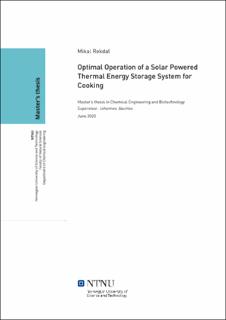| dc.contributor.advisor | Jäschke, Johannes | |
| dc.contributor.advisor | Nydal, Ole Jørgen | |
| dc.contributor.author | Rekdal, Mikal | |
| dc.date.accessioned | 2021-09-28T18:22:17Z | |
| dc.date.available | 2021-09-28T18:22:17Z | |
| dc.date.issued | 2020 | |
| dc.identifier | no.ntnu:inspera:57621272:34505432 | |
| dc.identifier.uri | https://hdl.handle.net/11250/2785350 | |
| dc.description.abstract | I denne masteroppgaven ble driften av et varmelagringssystem drevet av overskuddsenergi fra solcelleproduksjon for matlaging modellert og optimalisert. Hovedformålet med oppgaven var å undersøke systemets kapasitet under varierende forhold. En prototype av systemet har blitt konstruert på et laboratorium ved NTNU og i Arusha, Tanzania. Prototypen består av tre tønner med olje som varmes av overskuddsenergi og brukes som varmeoverføringsmedium for matlaging. En dynamisk modell av systemet ble utledet i fordypningsprosjektet og videreutviklet i dette masterprosjektet. Matlagingspotensialet under optimal drift ble videre undersøkt ved bruk av modellprediktivregulering med CasADi- rammeverket i MATLAB. Simuleringene antyder at det nåværende systemet er stort nok til å koke ris for 100 mennesker ved optimal regulering. Ved å øke antallet solcellepanel vil systemet være i stand til å lage mat både til lunsj og middag på en solrik dag. Andre modifiseringer på det fysiske systemet ble også modellert, som blant annet indikerte at et oppsett med to tanker er mer energieffektivt enn det nåværende tretanksystemet. | |
| dc.description.abstract | In this thesis, the operation of a solar powered thermal energy storage system for cooking was modeled and optimized. The main objective was to investigate the potential cooking capacity of the system during varying conditions. A system prototype has been constructed at a laboratory at NTNU and in Arusha, Tanzania. The prototype consists of three tanks with oil that are heated by excess solar power and used as a heat transfer medium for cooking. A dynamic model was developed during the specialization project and modified during this work. Then, the cooking potential of the optimally operated system was studied by using model predictive control with the CasADi framework in MATLAB. The simulations suggest that the current physical system is sufficiently large to cook rice for 100 people when operated properly. By increasing the number of solar panels, the system is able to cook both for lunch and dinner during a day of sunny conditions. Other modifications to the physical system were also modeled, which indicated that a setup of two tanks is more energy efficient than the current three tank system. | |
| dc.language | | |
| dc.publisher | NTNU | |
| dc.title | Optimal Operation of a Solar Powered Thermal Energy Storage System for Cooking | |
| dc.type | Master thesis | |
